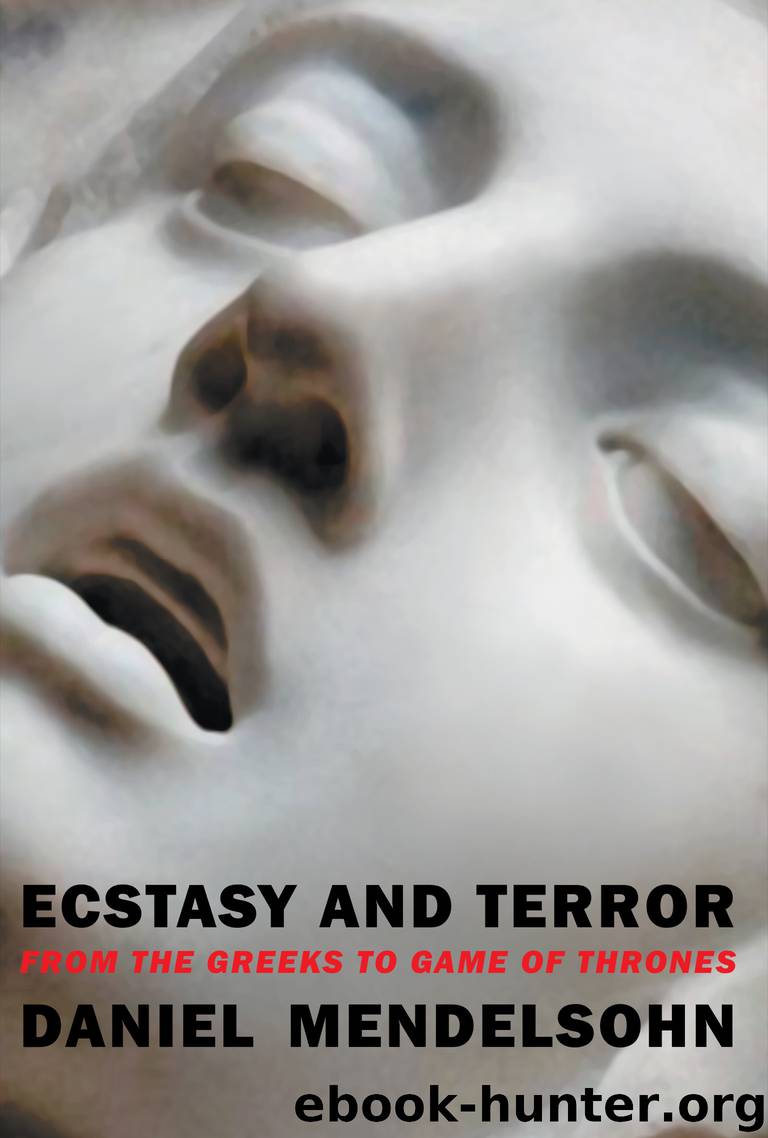Ecstasy and Terror by Daniel Mendelsohn

Author:Daniel Mendelsohn
Language: eng
Format: epub
Publisher: New York Review Books
Published: 2019-10-08T12:27:20+00:00
This is the conclusion to which many good biographies, to say nothing of some very good novels, also lead. “The poor thing that is himself ” is hardly the way that most of us would think about the first Roman emperor. It is the achievement of Williams’s novel that, by its end, we are able to do so, and to think of that end as a satisfying one.
—Introduction to John Williams, Augustus
(New York Review Books, 2014)
Weaving New Patterns
TOWARD THE BEGINNING of Ingmar Bergman’s Fanny and Alexander, a film at once deeply autobiographical and infused with improbable enchantments both bright and dark, a beautiful young boy wanders into a beautiful room. The room is located in a rambling Uppsala apartment belonging to the boy’s widowed grandmother, Helena Ekdahl, once a famous actress and now the matriarch of a spirited and noisy theater family. As the camera follows the boy, Alexander, we note the elaborate fin-de-siècle décor, the draperies with their elaborate swags, the rich upholstery and carpets, the pictures crowding the walls, all imbued with the warm colors that, throughout the first part of the film, symbolize the Ekdahls’ warm (when not overheated) emotional lives. Later, after the death of Alexander’s kindhearted father, Oscar, who is the lead actor of the family troupe, his widow rather inexplicably marries a stern bishop into whose bleak residence she and her children must move. (It’s no coincidence that the play Oscar was producing at the time of his death was Hamlet.) At this point, the film’s visual palette will be leached of color and life; everything will be gray, black, coldly white.
But for now, vivacity and sensuality and even fantasy reign. On a mantelpiece, an elaborate gilt clock ticks, its golden cherubs preparing their mechanized dance. Nearby, a life-size white marble statue of a nude woman catches the boy’s eye. When he blinks, she seems, Galatea-like, to come to life, one arm moving as if to beckon him to pleasures he has not yet even imagined; he blinks again, and the statue is just a statue once more. At that moment a violent rattling wakes him from his reverie: the maid is pouring coal into a stove.
The tension between the fantastical and the mundane, imagination and reality—symbolized above all by the difference between the aesthetically and emotionally extravagant Ekdahls and the tight-lipped bishop and his dour household—is one with which Bergman’s film is deeply preoccupied, from its opening shot of Alexander staring into a toy theater, to the scene a few moments later with the magically animated statue, to its final seconds, during which the grandmother recites the first lines of Strindberg’s A Dream Play: “On a flimsy framework of reality, imagination spins, weaving new patterns.”
To those familiar with Bergman’s life as well as his work, the opening of Fanny and Alexander is likely to provoke musings on the patterns that the imagination weaves on the framework of reality. For the room we see in the film is a version of a room that
Download
This site does not store any files on its server. We only index and link to content provided by other sites. Please contact the content providers to delete copyright contents if any and email us, we'll remove relevant links or contents immediately.
| Ancient & Classical | Arthurian Romance |
| Beat Generation | Feminist |
| Gothic & Romantic | LGBT |
| Medieval | Modern |
| Modernism | Postmodernism |
| Renaissance | Shakespeare |
| Surrealism | Victorian |
4 3 2 1: A Novel by Paul Auster(12281)
The handmaid's tale by Margaret Atwood(7678)
Giovanni's Room by James Baldwin(7189)
Asking the Right Questions: A Guide to Critical Thinking by M. Neil Browne & Stuart M. Keeley(5632)
Big Magic: Creative Living Beyond Fear by Elizabeth Gilbert(5610)
Ego Is the Enemy by Ryan Holiday(5294)
The Body: A Guide for Occupants by Bill Bryson(4974)
On Writing A Memoir of the Craft by Stephen King(4863)
Ken Follett - World without end by Ken Follett(4645)
Adulting by Kelly Williams Brown(4487)
Bluets by Maggie Nelson(4473)
Eat That Frog! by Brian Tracy(4434)
Guilty Pleasures by Laurell K Hamilton(4360)
The Poetry of Pablo Neruda by Pablo Neruda(4038)
Alive: The Story of the Andes Survivors by Piers Paul Read(3968)
White Noise - A Novel by Don DeLillo(3953)
Fingerprints of the Gods by Graham Hancock(3940)
The Book of Joy by Dalai Lama(3899)
The Bookshop by Penelope Fitzgerald(3775)
